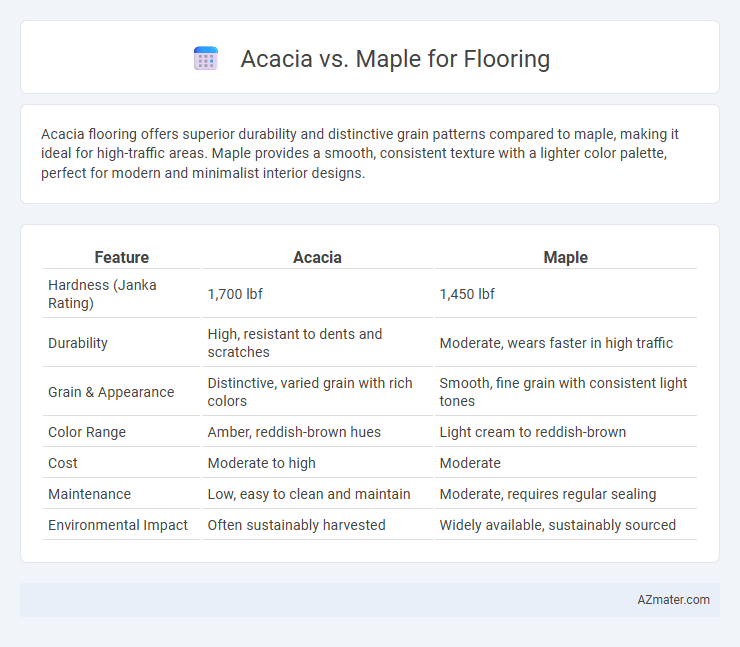Acacia flooring offers superior durability and distinctive grain patterns compared to maple, making it ideal for high-traffic areas. Maple provides a smooth, consistent texture with a lighter color palette, perfect for modern and minimalist interior designs.
Table of Comparison
| Feature | Acacia | Maple |
|---|---|---|
| Hardness (Janka Rating) | 1,700 lbf | 1,450 lbf |
| Durability | High, resistant to dents and scratches | Moderate, wears faster in high traffic |
| Grain & Appearance | Distinctive, varied grain with rich colors | Smooth, fine grain with consistent light tones |
| Color Range | Amber, reddish-brown hues | Light cream to reddish-brown |
| Cost | Moderate to high | Moderate |
| Maintenance | Low, easy to clean and maintain | Moderate, requires regular sealing |
| Environmental Impact | Often sustainably harvested | Widely available, sustainably sourced |
Introduction to Acacia and Maple Flooring
Acacia flooring is renowned for its durability, rich grain patterns, and natural resistance to scratches and dents, making it ideal for high-traffic areas. Maple flooring offers a smooth, consistent grain with a light color palette that brightens interior spaces while providing moderate hardness suitable for residential use. Both wood types provide unique aesthetic and functional benefits, with Acacia's exotic appeal contrasting against Maple's classic elegance.
Appearance and Grain Patterns
Acacia flooring showcases a rich, warm hue with striking contrast between dark and light tones, featuring pronounced, swirling grain patterns that add a unique, rustic charm to interiors. Maple flooring offers a smoother, more uniform appearance with subtle grain variations and a lighter, creamier color palette, lending a clean and contemporary look. Both woods provide distinct aesthetic qualities, with Acacia delivering bold textures and Maple favoring understated elegance.
Durability and Hardness Comparison
Acacia flooring offers superior hardness with a Janka rating of approximately 1,700, making it one of the hardest hardwood options, while maple typically has a Janka rating around 1,450, indicating slightly less resistance to dents and wear. Acacia's natural density and resilience provide enhanced durability, especially in high-traffic areas, whereas maple, although durable, may show signs of wear more quickly under heavy use. Both woods excel in longevity, but Acacia's exceptional hardness often translates to a longer-lasting surface, ideal for durability-focused flooring applications.
Color Range and Aesthetic Appeal
Acacia flooring showcases a wide color range from golden honey to rich reddish-brown tones, offering a vibrant and exotic aesthetic appeal that enhances modern and rustic interiors alike. Maple flooring typically presents lighter shades, ranging from creamy white to light reddish hues, lending a clean, classic, and versatile look suitable for various design styles. The choice between Acacia and Maple for flooring depends on the desired visual impact, with Acacia providing bold, dramatic contrasts and Maple delivering a subtle, uniform elegance.
Maintenance and Care Requirements
Acacia flooring requires regular dusting and occasional damp mopping to maintain its rich, natural luster while resisting scratches due to its hardness rating of 2350 on the Janka scale. Maple flooring, with a slightly lower hardness rating of 1450, demands gentle cleaning methods and immediate spill cleanup to prevent water damage and surface wear. Both wood types benefit from periodic refinishing every 5-7 years to preserve durability and appearance, but Acacia's higher density generally results in lower maintenance frequency.
Installation Methods and Flexibility
Acacia flooring features a tongue-and-groove installation method that ensures a tight fit and reduces gaps, making it ideal for floating, nail-down, or glue-down installations on various subfloors. Maple flooring also uses tongue-and-groove systems but is primarily installed through nail-down or glue-down methods, which offer strong stability, especially on wooden subfloors. Acacia's natural flexibility allows it to adapt better to humidity changes, making it suitable for more diverse environments, whereas maple is more rigid and thrives in controlled indoor climates.
Cost and Value Analysis
Acacia flooring typically costs between $5 to $9 per square foot, offering a mid-range price point with high durability and unique grain patterns that add substantial value to homes. Maple flooring, priced similarly around $6 to $12 per square foot, provides a harder surface with a more uniform appearance, often preferred for its resistance to dents and scratches. While both offer excellent long-term value, Acacia's exotic look can enhance property appeal more significantly, whereas Maple's consistent quality suits high-traffic areas, influencing cost-effectiveness based on specific flooring needs.
Environmental Impact and Sustainability
Acacia flooring is often praised for its fast growth rate and ability to be sustainably harvested, making it a more eco-friendly option compared to slower-growing hardwoods like maple. Maple flooring, while durable and attractive, typically requires longer harvesting cycles that can contribute to deforestation and habitat loss if not sourced responsibly. Choosing Acacia certified by organizations like FSC ensures better environmental practices and supports sustainable forest management.
Suitability for Different Room Types
Acacia flooring offers exceptional hardness and durability, making it ideal for high-traffic areas such as living rooms and hallways where resistance to dents and wear is crucial. Maple flooring provides a smoother, uniform grain that suits bedrooms and offices, offering a refined aesthetic with less susceptibility to scratches in lower-traffic environments. Both species handle moisture moderately well, but Acacia's natural oils give it better resistance in kitchens and bathrooms compared to Maple hardwood.
Final Verdict: Choosing Between Acacia and Maple
Acacia flooring offers exceptional hardness and distinctive grain patterns, making it ideal for high-traffic areas requiring durability and a unique aesthetic. Maple provides a more uniform appearance with a lighter color palette and slightly lower hardness, suited for modern, sleek interiors. Choosing between Acacia and Maple depends on balancing the desired hardness, visual style, and budget, with Acacia favoring resilience and character while Maple suits clean, consistent looks.

Infographic: Acacia vs Maple for Flooring
 azmater.com
azmater.com